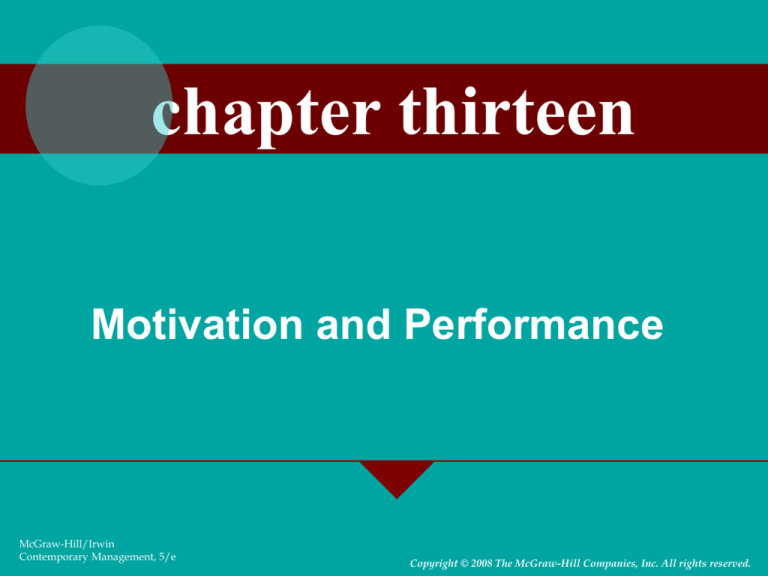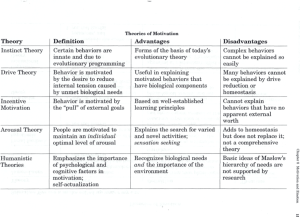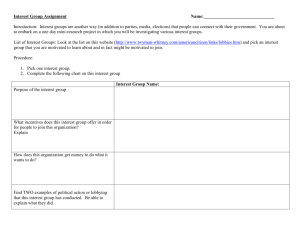
chapter thirteen
Motivation and Performance
McGraw-Hill/Irwin
Contemporary Management, 5/e
Copyright © 2008 The McGraw-Hill Companies, Inc. All rights reserved.
Learning Objectives
1. Define motivation.
2. Understand numerous different approaches to
how employees are motivated in the workplace
Maslow’s Hierarchy of Needs
Herzberg’s 2-Factor Theory
McClelland’s Theory of Needs
Equity Theory
Expectancy Theory
Operant Conditioning Theory
3. Serve up Real World Motivational practices
McGraw-n
© 2005 The McGraw-Hill Companies, Inc. All rights reserved.
Q. Why is motivating employees (or not)
one of the most important things a
manager does?
McGraw-Hill/Irwin
© 2005 The McGraw-Hill Companies, Inc. All rights reserved.
The Nature of Motivation
Motivation - The psychological forces that
determine the direction of a person’s behavior
in an organization, a person’s level of effort,
and a person’s level of persistence
• Direction - possible behaviors the individual
could engage in
• Effort - how hard the individual will work
• Persistence - whether the individual will keep
trying or give up
13-4
Defining Motivation
Motivation is not a personality trait, which
either you have or you don’t…
Motivation is something everyone has and
it varies by individual and between
individuals based upon the situation
The Nature of Motivation
• Intrinsically Motivated Behavior
– The sense of accomplishment and
achievement derived from doing the work
itself
• Extrinsically Motivated Behavior
– Behavior that is performed to acquire material
or social rewards or to avoid punishment.
– The source of the motivation is the
consequences of the behavior and not the
behavior itself.
13-6
Outcomes and Inputs
• Input - Anything a person contributes to his or
her job or organization (Time, effort, skills,
knowledge, work behaviors)
• Outcome - Anything a person gets from a job
or an organization (pay, job security, autonomy,
accomplishment)
13-7
The Motivation Equation
Figure 13.1
13-8
Motivation Theory #1 –
Maslow’s Hierarchy of Needs
Maslow’s Hierarchy of Needs – humans will
strive to meet needs, only moving on to
higher level needs once a need is met.
Implication – In order to motivate people,
you must try to meet the lowest level of
unmet needs that they have
.
Motivation Theory #1 – Maslow’s
Hierarchy of Needs
Higher-order needs
Selfactualization
Self-fulfillment
Esteem or ego
Recognition, Confidence,
Success, Strength
Social
Acceptance, Belonging, Love, Affection
Safety
Security, Protection, Comfort, Peace, Surroundings
Physiological
Food, Thirst, Sleep, Health, Body needs, Exercise, Rest
McGraw-Hill/Irwin
Lower-order needs
© 2005 The McGraw-Hill Companies, Inc. All rights reserved.
Maslow’s Hierarchy of Needs
Needs
Highest-level
needs
Lowest-level
needs
Table 13.1
Description
Examples
Selfactualization
Realize one’s
full potential
Use abilities
to the fullest
Esteem
Feel good
about oneself
Promotions
and recognition
Belongingness
Social
interaction, love
Interpersonal
relations, parties
Safety
Security, stability
Job security,
health insurance
Physiological
Food, water,
shelter
Basic pay level
to buy items
Lower-level needs must be satisfied
before higher-level needs are addressed.
13-11
Motivation Theory #2 – Herzberg’s
2-Factor Theory
•Maintenance Factors – Workplace elements that
must be present to prevent dissatisfaction, but being
present doesn’t cause motivation
•Motivating Factors – Workplace elements that
when present will motivate employees
Implication – There are certain factors (like money)
which won’t motivate most employees but can demotivate them if not decent. There are other factors
which can motivate employees
Herzberg’s Maintenance Factors and Motivating Factors
Maintenance Factors (Not Motivators,
but Prevent Dissatisfaction):
Motivating Factors
(Directly Lead to Satisfaction):
Job Enrichment Herzberg
1. Company policy and administration
1. Opportunity for achievement
2. Supervision
2. Opportunity for recognition
3. Relationship with supervisor
3. Work itself
4. Relationship with peers
4. Responsibility
5. Working conditions
5. Advancement
6. Salary
6. Personal growth
7. Relationship with subordinates
.
Motivation Theory #3 – McClelland’s
Acquired Needs Theory
People acquire 3 groups of needs through their life
experiences, especially early in life:
• Need for Achievement – motivated by meeting
challenges
• Need for Power – motivated by responsibility
• Need for Affiliation – motivated by approval
Implication - If a manager understands which of these 3
types of needs is most important for an employee,
then they can be motivated accordingly
.
Motivation Theory #3 - McClelland’s
Acquired Needs Theory
nPow
nAch
nAff
Motivation Theory #3 – McClelland’s
Acquired Needs Theory
Q. Based upon the McClelland’s Theory,
what Need are you most motivated by?
• Need for Achievement – motivated by meeting
challenges
• Need for Power – motivated by responsibility
• Need for Affiliation – motivated by approval
Motivation Theory #3 – McClelland’s
Acquired Needs Theory
* Implication - You will likely be happiest by seeking
out a work environment that matches your
primary Need:
• N power - Likely to be happiest in jobs that give you
control over budgets, people, and decision-making.
• N achievement - Likely to be happiest working in an
environment in which you can create something new.
• N affiliation – Likely to happiest when you can be
working with other people and can form friendships.
McGraw-Hill/Irwin
© 2005 The McGraw-Hill Companies, Inc. All rights reserved.
Motivation Theory #4 – Equity
Theory
Equity theory - People want to be treated fairly in
relationship to others.
– Inequity exists when a person perceives his or
her job inputs (such as effort, skills, and
experience) and outcomes (such as pay) to be
different than the job inputs and outcomes of
another person.
McGraw-Hill/Irwin
© 2005 The McGraw-Hill Companies, Inc. All rights reserved.
Motivation Theory #4 – Equity
Theory
Q. Have you ever seen someone throttle
back their work effort because they felt they
were underpaid? Or increase their effort
because they felt they were overpaid?
Motivation Theory #4 – Equity
Theory
A person might take several actions to reduce
inequity:
– Increase efforts on the job
– Reduce efforts on the job
– Quit the job.
– Request a pay increase.
Implication – It is human nature for employees to
compare their efforts and rewards to others,
therefore managers need to be as fair as possible
in rewarding all employees for their efforts.
McGraw-Hill/Irwin
© 2005 The McGraw-Hill Companies, Inc. All rights reserved.
Motivation Theory #5 –
Expectancy Theory
Expectancy Theory is best expressed in the following
formula:
Implication – Managers must reward achievements in
ways that are meaningful to individual employees.
.
Motivation Theory #5 –
Expectancy Theory
An employee’s motivation will be maximized when
they answer “yes” to the following questions:
1. If I give a maximum effort, will it be recognized?
2. If it is recognized, will it then be rewarded?
3. If it is rewarded, are the rewards attractive to
me?
If the employee does not expect the answer to be
“yes” to each question, they won’t be motivated
Q. Does this apply to you personally?
Q. In the workplace, what motivates you
the most?
Q. Other than using monetary incentives,
how would you motivate your
followers?
Motivation Theory #6 - Operant
Conditioning Theory
• Operant Conditioning
– People learn to perform behaviors that lead
to desired consequences and learn not to
perform behaviors that lead to undesired
consequences.
– Linking specific behaviors to the attainment
of specific outcomes (such as pay raises or
recognition) can motivate high performance
and prevent negative behaviors.
13-24
Operant Conditioning Tools
Positive Reinforcement - Gives people
outcomes they desire when they perform
organizationally functionally behaviors
– Positive reinforcers: Pay, praises, promotions
Negative Reinforcement - Eliminating undesired
outcomes once the functional behavior occurs
– Negative reinforcers: criticisms, pay cuts,
suspension
13-25
Avoiding Side Effects of Negative
Reinforcement
• Downplay the emotional element
involved
• Try to punish dysfunctional behaviors as
soon as they occur
• Try to avoid punishing someone in front
of others
13-26
In the Real World…
Ways to Motivate Followers
Take an individualized approach
Understand Responsibility, Authority,
Autonomy & Accountability = pride & selfesteem
Build a team
Install a flexible benefits program
Utilize job design techniques
Provide Great Leadership!
Properly use recognition
Individualizing Motivation
1. Understand that each individual has
different motivators and individuals are
motivated differently depending upon the
situation
2. Understand that Motivation is not a
personality trait, which either you have or
you don’t. It is by degree for everyone
3. Invite employees to participate in
determining their own rewards
4. Make certain that motivation is being
handed out equitably
Individualizing Motivation
5. Connect rewards to both individual & team
performance
6. Ensure that employees are both having fun
and producing
7. Balance the needs of the employee with the
needs of the organization (provide the best
reward under the circumstances)
8. View individuals as followers, not as
employees!





